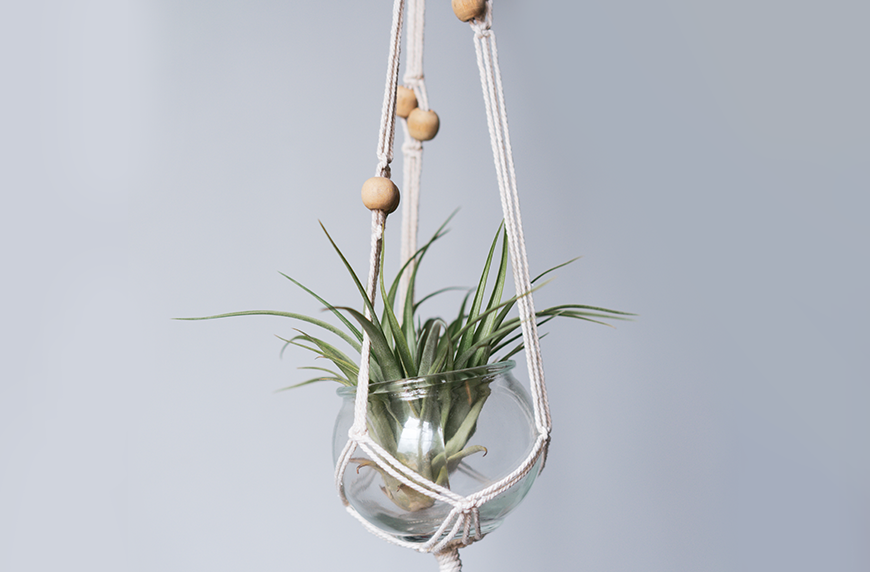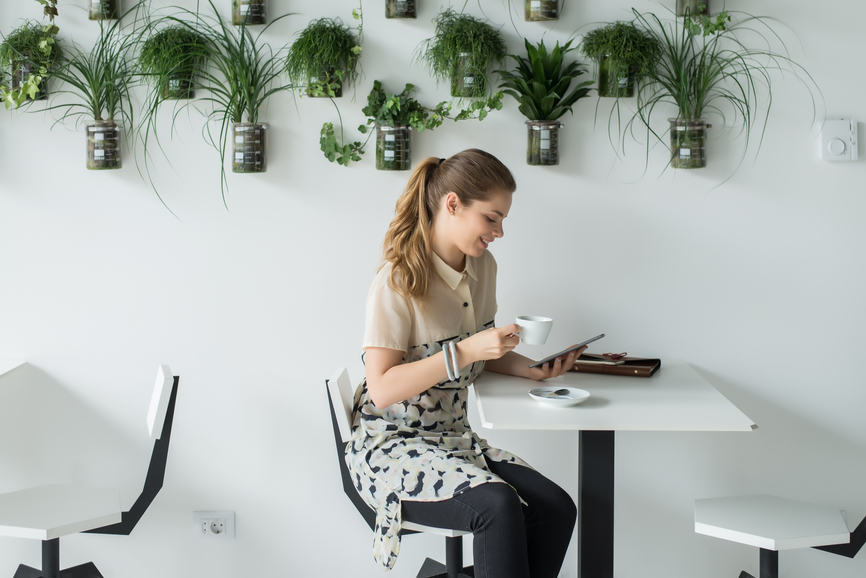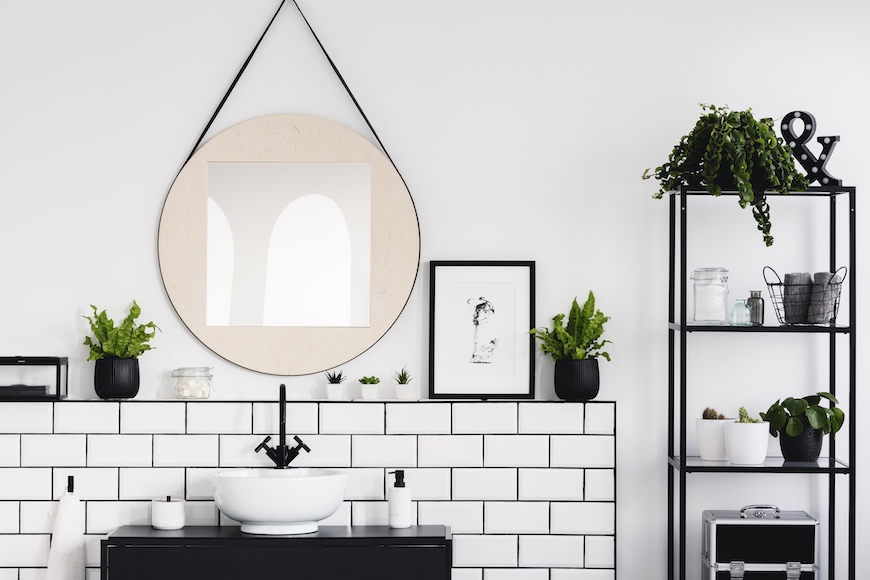As a notoriously bad-at-plants person, I have decided to turn over a new leaf and be a responsible adult who can keep plants alive, which is what led me to an exhaustive search to find indoor garden ideas. Since I am (clearly) not a plant professional, I reached out to Erin Marino, director of brand marketing at The Sill, to get her tips.
Here, indoor plant ideas for every skill level and personality type. By the end, you're definitely going to be a person who follows a bunch of plant moms on Instagram. Embrace it.
For the person who accidentally kills all their plants: air plant terrariums

While succulents may currently be your go-to for easy plants, you should also consider air plants. They're basically just as easy to take care of, and look very cute hanging from your walls or placed among your astrology textbooks and Jonas Brothers records (or, idk, whatever it is you decorate your place with). Plus, air plants can be put in a variety of different cute containers.

{{post.sponsorText}}
Although they're called air plants, they do need water to survive. A light misting once a week should do it, though you may have to give them a bath every once in a while (more details here). And before you go all, "Wait, I have to bathe my plants?" may I ask—what else is occupying your time right now? Baking your hundredth loaf of bread to show off on Instagram can wait. Give the people this new content.
What to buy:
- Mkono 4 Inch Mini Glass Geometric Terrarium Container Set, $27
- Indoor Tabletop Irregular Glass Geometric Air Plants Terrarium, $30
- Ivolador Terrarium Container, $16
- Air Plant Trio, $36
For the person who has a green thumb: a plant shelf

I'm using the word "shelf" here loosely. Group various plants together on your bookshelf, windowsills, a bar cart… you get the gist. This lush garden look falls into the "more is more" category, making it perfect for someone who is pretty confident in their ability to keep plants alive. "Most common houseplants are either leafy green tropical plants or succulent desert dwellers. These types of plants tend to fare well in an indoor environment when temperatures are generally stable," says Marino.
When pairing plants together for your indoor garden, she recommends putting plants that require the same type of light and care together. "For example, I group all my succulents together: echeveria, haworthia, cacti, euphorbs. A miniature indoor desert if you will, right in front of the brightest window in my apartment," she says.
She suggests putting leafy green tropicals in spaces where the light is less strong and more indirect. "I love grouping different sizes and heights together, in matching but not exactly the same planters, to make it feel considered—like mini vignettes—verses like a plant store (which can happen when you have 40+ houseplants!)" My head is spinning imagining having to care for dozens of houseplants.
What to buy:
- Mkono Cotton Rope Plant Basket, $18
- Exquis Home White Ceramic Flower Pot, $34
- MyGift Round Modern Ceramic Flower Pots, $22
- Echeveria Agavoides, $26
- Haworthia Zebra, $27
For the person who loves a project: a living wall

"Living walls can be tricky but there's definitely different planter options out in the market that have made it easier for plant people to build their own living wall at home," says Marino. Properly hanging planters and making sure they're super secure on your wall is key. "A dry plant might not weigh much but as soon as you water it, and the potting mix soaks up all that water, it'll weigh more. Keep that, and drainage, in mind. No one wants brown water running down their living room wall!" Truth. Getting creative with your shelving and wall-hanging plants is a good way to fake a plant wall, without having to worry about gravity.
What to buy:
- 12 Pocket Indoor Waterproof Vertical Living Wall Planter, $33
- Ortisgreen Indoor Vertical Garden, $49
- Morandi Color Ceramic Hanging Geometric Wall Decor, $55
For the person using quarantine to become a better chef: herb garden

"Growing herbs is a satisfying way of exercising your green thumb, specifically because your hard work can save you a trip to the store! An indoor herb garden is relatively easy to grow, as long as you have the proper light," says Marino. Herbs need lots and lots of natural sunlight—think four to five hours a day. "Usually windows with a south or southwest exposure are ideal, but east or west will work as well," she says. If your space gets medium-to-low light, you can grow herbs at home with some help. Purchase grow lights and position them over your herbs for at least six hours a day. Lastly, remember to rotate your herbs’ containers regularly for even light exposure and growth.
If you need a starter herb, says Marino that basil is popular and easy to grow. As an added bonus, you can use it in a lot of the recipes you're making whilst quarantining, like pasta sauce or, if you're me, cocktails. Using snippings regularly is the way to go, she says, because most herbs need to be pruned on a weekly basis to encourage studier, more compact growth. "In addition to basil, you can give chives, oregano, thyme, rosemary, and even mint—refreshing in a summer drink!—a try," says Marino. Look out, Oprah.
What to buy:
- Greenaholics Plant Pots , $29
- SQOWL Rectangular Planter Pot, $25
- Plaid 3 Metal Planting Pots In Tray, $9
- Grow Lights Plant Light, $28
- Back to the Roots Basil/Cilantro/Mint Grow Kit, $23
For the person who doesn't have a ton of space: clustered plants

"For a small space like an apartment, I recommend starting off with smaller-sized plants," says Marino. Look for a mix of different pots with diameters of four inches or below and planters. Also, she recommends doing small groupings of three-to-five potted plants around your space to make an impact. "If you’re lucky enough to have bright direct light in your space—opt for succulents and cacti, which are slower growers, so you don't have to worry about them taking over. If you're low on natural light, go with vertical growers like snake plants or ZZ plants on tabletop surfaces, or trailing pothos plants on high shelves, or in hanging planters," she says.
What to buy:
- Stone & Beam Mid-Century Patterned Planter, $33
- Rivet Rustic Stoneware Crosshatch Indoor Outdoor Flower Plant Pot, $18
- Large Ceramic Plant Pot with Stand, $58
- Snake Plant Laurentii, $62
- ZZ Plant, $44
For the person who would've gone to a music festival this year: hanging plants

"Generally speaking, any plant can be hung if in the right container," says Marino. (Did anyone else's mind jump to this? No? Just me?) She says plants like the heartleaf philodendron and the marble queen pothos lend themselves to hanging. "Both are fast-growing vining plants with vibrant heart-shaped leaves," says Marino. Equally as perfect for hanging is the philodendron silver, she says.
"In terms of tips for hanging plants, I’m a renter who is afraid to drill into my ceiling, so I opt for wall planters instead," says Marino. "Seamless, white planters like this one are my favorite because they give the illusion the plant is suspended from the wall. These mixed with a few floating shelves, with potted plants, is an easy DIY grow wall without too much commitment." Marino is also a fan of Jamie Song’s approach using a trailing neon pothos "He uses 3M clips to help the plant trail upward, which I think is a really fun and refreshing approach to decorating with plants," she says.
What to buy:
- Petutu Indoor Hanging Planter Holders, $21
- La Jolie Muse Ceramic Hanging Planters Plant Pots - 5.5 Inch White Indoor Hanging Pots, $28
- Beatrix Planter, $36
- 3M Command Command Decorating Clips, Clear, 60-Clip, $17
- Heart Shaped Philodendron, $35
- Silver Philodendron, $35
- Pothos, $37
For the person who considers the shower their sanctuary: bathroom plant assortments

Anyone else been crying in their shower a lot more often? Make your cry space seem mildly less depressing by adding some plants. "Provided you have a window, the bathroom is a great spot for plants that appreciate a little extra humidity that a room with a shower can provide. This space mimics some plants’ native tropical habitat—so if you’re a brand new plant parent, that bathroom environment can actually help you keep some plants thriving," says Marino. "Not to mention a new plant is a simple way to update a bathroom and give it a spa-like feel."
The first thing you need to do is identify how much natural light your bathroom gets, which is a good rule of thumb when deciding on plants for any of these indoor garden ideas. "If you don’t have a window in your bathroom, opt for a faux or preserved plant instead," says Marino.
The best plants for bathrooms
"If I had a bathroom with natural light, I’d opt for a beautiful blooming orchid or anthurium right next to the window to bring in some color and cheer, and a leafy trailing plant next to the shower, maybe hanging off the shower rod (if not in direct way of the water) to give my showers outdoor vibes," says Marino. And I don't know about you, but I definitely could use a reminder of what the outdoors is like.
1. Bird's Nest Fern, $39
"There’s a variety of humidity-loving ferns out there to choose from, but one of my favorites is the Bird’s Nest Fern. I love the large, wavy bright green fronds," says Marino. "It’s also considered non-toxic, making it safe to keep around your cat or dog. It thrives in medium-to-bright indirect light, but can tolerate low indirect light."
2. Phalaenopsis orchid, $75
"Native to the tropics in India, China, and Southeast Asia, the phalaenopsis orchid with its leafy stems and long-lasting blooms does best in a sunny, warm, and humid environment. Very spa chic," says Marino. "If your bathroom has a big, bright window, this is the plant for you! It thrives in bright indirect light, but can tolerate medium indirect light."
3. Pink Anthurium, $65
"If you’re looking to add a pop of color to your bathroom all year round, look no further than the world’s longest blooming houseplant," says Marino. "The anthurium is rarely without their showy blooms, which aren't really flowers but are modified waxy leaves. It thrives in bright indirect light, but can tolerate medium indirect light."
4. Marble Queen Pothos, $37
"Nicknamed the ‘cubicle plant’ because of its tolerance of low light, or less than ideal conditions, the marble queen pothos is a hardy pick for any space, even a bathroom! A low maintenance trailing plant, it’s perfect for hanging off your shower curtain rod," says Marino. "It thrives in medium to low indirect light."
Loading More Posts...